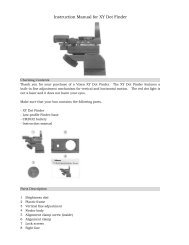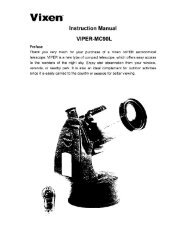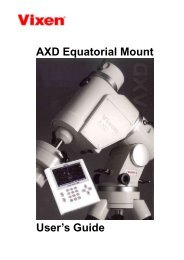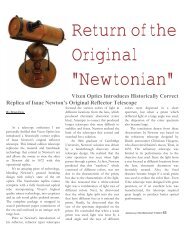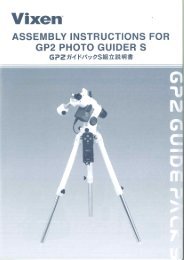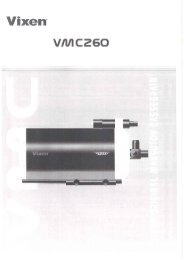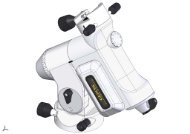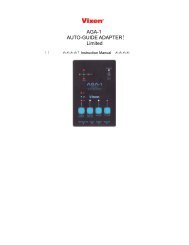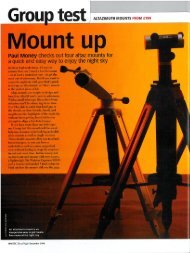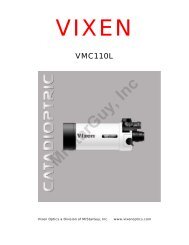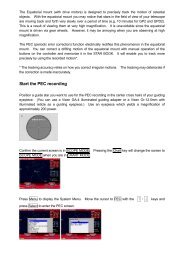Definitely Not Your Average Barn-Door Tracker - Vixen Optics
Definitely Not Your Average Barn-Door Tracker - Vixen Optics
Definitely Not Your Average Barn-Door Tracker - Vixen Optics
- No tags were found...
You also want an ePaper? Increase the reach of your titles
YUMPU automatically turns print PDFs into web optimized ePapers that Google loves.
VIXEN POLARIEFigure 1 - M42 wide field; ten 15-second exposures with a Canon T2i and 50-mm lens.laris (see the connection?). Next I tilted thehead so that I could see Polaris through thepolar alignment sight.Oh yeah, there’s that little dial on thetop of the unit. Turn that to the “Preparation”position and the tilt meter lights up.Tilt the head holding the Polarie until thetilt-meter indicator roughly matches yourlatitude. This should get you close to whereyou can see Polaris through the built-inpolar-alignment sight. Use the head holdingthe Polarie to adjust the polar alignmentso that Polaris is centered in the polar alignmentsight. Once you’ve performed thesesteps, you’re ready for some wide-field astrophotography.Before you start, switch the mode dialto the picture of a star for diurnal trackingrate. As you can see in Figure 1, I was ableto achieve pretty nice stars using 30-secondexposures. As you move further from theequator you should be able to increase exposurelength without star trails. <strong>Vixen</strong> hasincluded a table in the user guide indicatingrecommended exposure limits for variouslens focal lengths combined with latitudeseparation from the equator. My locationindicated roughly 2-minute maximums forthis combination, but I was unable to gothat long using rough polar alignment. I’msure more careful alignment would get mecloser to the recommended limits.To achieve longer exposures, you needmuch better polar alignment. <strong>Vixen</strong> has asolution for that. Remove the camera54 Astronomy TECHNOLOGY TODAY
VIXEN POLARIEmounting block and the compass from thePolarie and insert the optional polar-alignmentscope (see insert Image 1) and you’llbe able to achieve a much more accuratepolar alignment. Once I did that, I was ableto take 7-minute exposures and retain niceround stars. I’m sure I could have gonelonger. Sadly, my sky conditions made thestars all but invisible after that amount oftime, even at low ISO settings.Figure 2 shows the full frame of a single7-minute exposure while Figure 3shows a crop of the same image at 100-percentresolution. The processing of thisimage was a levels adjustment to darken thebackground and little bit of noise reduction.If you ignore the remaining noise in theimage, you can see that the stars are quiteround in these images.With a little patience and a fine polaralignment, I was able to generate the imageshown in Figure 4. For this image, I usedthe T2i with a 135-mm lens. This time Itook 15 exposures of 2 minutes each. Theexposure length was limited by my sky con-Figure 2 - A single 7-minute exposure.ditions, not the ability of the Polarie. I alsooriented the camera vertically to provide adifferent composition from that of the thewide-field view shown in Figure 1.As you can see, there is quite a bit ofdata in there, even with the limited total exposuretime and despite the levels of lightpollution I deal with on a regular basis. Youcan also see that the foreground tree isblurred by the length of the exposure andAstro-TechTele VueZhumel<strong>Vixen</strong>iOptronASTRONOMY PRODUCTSLAYAWAY: Do you need new accessories for your telescope butare short on cash? We can help! Place your needed accessories,eyepieces, mounts, etc. on layaway, and pay them off later.So what are you waiting for? With the Great Red Spot Layawayprogram, you can have those new items on time for yourholiday gifts.PAYPAL INSTANT CREDIT: Would you like to purchase today,but can't quite afford the cost all at one time? Get your itemwith PayPal's Buyer Credit Financing. It doesn't get anyeasier! You'll be able to order your item right away and benefitby making smaller, more affordable payments. The choiceis yours!Astronomy TECHNOLOGY TODAY 55
VIXEN POLARIEtracking modes: (1) Star-Scape Photography,which tracks at halfspeed; (2) Wide-FieldAstrophotography,which tracks at full speedto prevent star trails; (3)Solar Tracking, whichtracks at mean solarspeed; and (4) LunarTracking, which tracks atmean lunar speed.Obviously, I used theWide-Field Astrophotographysetting forthese images. For compositionsthat includeforeground objects orFigure 3 - This crop of Image 2 reveals nice, round stars. landscape features, youthe tracking of the mount. There’s also a bitof movement in the branches over time(darn wind), but I think it makes for a moreinteresting image than if I had shot earlierand not included the tree.The Polarie supports the four followingcould use the Star-Scape setting to generateimages where the foreground is not blurred,however, that would also limit the maximumduration of your exposures in orderto achieve images without star trails. I suspectit will also limit the overall exposuretime or the stars will have moved enoughrelative to the foreground to cause eitherstar trails or blurring of the foreground subject.Unfortunately, I did not have enoughtime with the Polarie to explore this settingfully, but think it could be a very interestingmode if you have a fast enough camera lensand some interesting foreground material.The solar and lunar tracking modes arepretty self explanatory. I don’t have any gearthat is light enough for use in the solarmode and there wasn’t enough time for meto do anything with the lunar mode duringthis project.I don’t normally include a pro/con listin my articles, but I will this time because Ithink there are some compelling reasons.Unlike every other pro/con list I’ve everread, I’m going to start with the cons. I hateto end an article with the cons when thereis so much more to like about the <strong>Vixen</strong> PolarieStar <strong>Tracker</strong>.ConsThe documentation for the Polarieneeds work. While the basic operation descriptionis fine, there is room for improvementin the areas describing the externalpower supply and those that explain the thevarious tracking rates. Granted, these arepretty easy to figure out for those of us whohave been at this a while, but anyone new toastrophotography might find the lack of detailon those departments a little daunting.The documentation for the polaralignmentscope needs quite a bit of work.The description of how to set the date andtime on the polar alignment scope is incomplete,and the diagrams did more tohelp me understand how to set it up thandid the descriptions. Also, as I read it, thedescription of the final step of orienting thepolar alignment scope in the Polarie conflictswith the diagram. The diagram is accurate,however, the accompanying wordswould have you pretty much undo the constructivework done to that point. I understandthe difficulties in accuratelytranslating from one language to another(<strong>Vixen</strong> products are produced in Japan),56 Astronomy TECHNOLOGY TODAY
A TechnicalLookat the<strong>Vixen</strong>Image 1PolarieImage 2 Image 3 Image 4 Image 5 Image 6Features and SpecificationsThe Polarie incorporates a 144-tooth,full-circle aluminum-alloy wheel gear thatmeasures 57.6 mm in diameter, matchedto a high-tension brass worm gear of 9mm diameter driven by a stepper motorpowered by two internal AA-size batteriesor by an external power supply via USBmini.A pair of standard Alkaline batterieswill power the unit for approximately 4hours with a 3.3-pound (1.5-kilogram)payload.The unit weighs 1.4 pounds(0.635029 kilogram) and measures 3.7inches by 5.9 inches by 2.3 inches(95x137x58 mm).Despite that its namesake is the targetagainst which users in the NorthernHemisphere perfect alignment, Polarie iseasily converted to use in the SouthernHemisphere as well.58 Astronomy TECHNOLOGY TODAY
A TECHNICAL LOOK AT THE VIXEN POLARIEThe <strong>Vixen</strong> Polarie Star <strong>Tracker</strong>User’s Guide is available at: http://www. vixenoptics.com/PDF/PO-LARIE%20Manual.pdfOptional AccessoriesDedicated Polar-Axis ScopeThe 6x20 alignment scope isequipped with a precision-engraved dialthat overlays a Meridian-offset scale ontoa time-graduation circle, as shown inImage 1. A fluid level is built into thebottom of the dial. Image 1 offers therear right view (as viewed by users inthe Northern Hemisphere) of the Polarieinto which the Dedicated Polar-AxisScope has been inserted. The built-inpolar viewer is located at the upper leftcorner of the back of the unit, while thebuilt-in illuminated tilt meter is inset intothe “left” side of the Polarie. The modedial is positioned to the right of the topside of the Polarie.<strong>Vixen</strong> Tripod with TwoBall HeadsShown in Image 2 is the optional<strong>Vixen</strong> Tripod that includes two ball-headmounts: one for attachment of the Polarieto the tripod and another for attaching acamera to the Polarie. The novel design ofthe tripod facilitates easy, intuitive onehandedadjustment of altitude alignmentof the Polarie. The highly portable tripodfeatures 4-section legs and collapses to aminimum length of 22 inches, while itsSUBSCRIBE NOW!!!BUY A FRIENDA GIFTSUBSCRIP-ASTRONOMYTECHNOLOGY TODAYwww.astronomytechnologytoday.comImage7working height range is from 21.2 inchesto 70 inches (540 mm to 1780 mm). Itsgeared elevator-pole extension has an adjustmentrange of 11.4 inches (290 mm).Its maximum load capacity is 6.6 pounds(3.0 kilograms) and the Polarie itselfweighs 4.3 pounds (1.98 kilograms) sanspan head.Polarie Polar MeterThe optional dedicated Polarie PolarMeter (Image 3) attaches to the “flash”foot on top of the Polarie, as shown inImage 4, and simplifies initial polar alignmentto three basic steps: (1) Set the PolarMeter’s altitude scale to the latitude ofyour location, (2) point the Polar Metertoward North using the built-in oil-filledcompass, and (3) level the meter so thatthe bubble is centered in the built-inchbubble level. For Northern Hemisphereusers, Polaris will then appear in the Polarie’sbuilt-in polar viewer.Other Polarie ImagesImage 5 reveals the “right” side of thePolarie which contains the battery doorand USB-mini plug receptacle. In Image6 the Polarie is featured mounted on the<strong>Vixen</strong> Tripod, and polar aligned withcamera attached and ready for imaging.Image 7 offers an image of the MilkyWay, captured by Kouji Ohnish using thePolarie Star <strong>Tracker</strong>.Astronomy TECHNOLOGY TODAY 59


